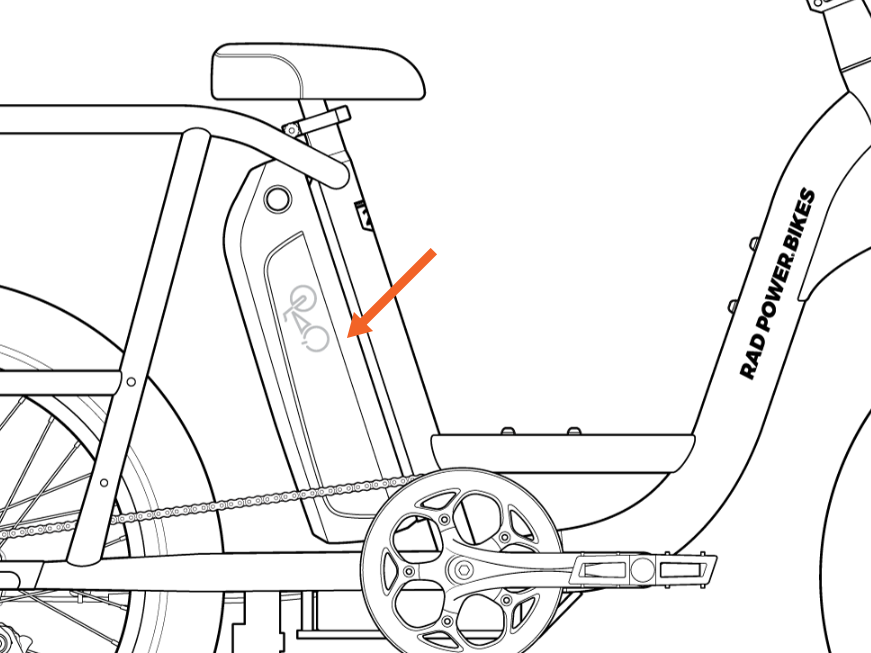Battery essential resources
Use this article to learn the basics of battery usage on your ebike, including how to power on the battery, remove the battery, check the battery charge level, battery range and life expectations, and how to recycle a battery.
- Refer to the Lithium-Ion Battery Safety Manual for important safety, performance and service information regarding lithium-ion batteries (per New York Assembly Bill A1910A, this manual has been translated into the twelve most common non-English languages spoken in the state).
- Refer to your ebike's Owner's Manual for specific features and operation details for the battery that came with your ebike.
- Refer to the Battery Charging Guide article for an overview of best practices for charging and long-term storage.
Using a damaged battery or charger can damage additional components or create a fire hazard. Stop using your battery and charger and contact Rad Power Bikes immediately if any of the following occur:
- Your charger’s flexible power cord or output cable or any of the electrical cables on your is frayed, has broken insulation, or any other signs of damage,
- Your battery or charger is physically damaged, non-functional, or performing abnormally,
- Your battery or charger experienced a significant impact from a fall, crash, or shipping damage, with or without obvious signs of damage,
- Your battery is leaking a clear, pungent, gel-like substance (which is potentially corrosive and flammable),
- Your battery was submerged in liquid or had extensive water exposure or damage, or
- Your charger becomes too hot to touch (it’s designed to get warm with normal use), makes an unusual smell, makes a popping sound, or shows other signs of overheating.
Store any damaged battery or charger in a safe, dry location away from the house and other flammable materials/structures and, as soon as possible, recycle or otherwise dispose of it according to local rules. Contact Rad Power Bikes Product Support if you have any questions. In the case of a leaking battery as described above, call Rad Power Bikes immediately.
Most ebike models use an external or semi-integrated, 589 to 672 Wh, Lithium-Ion battery with a Battery Management System (BMS). The following models have different batteries:
- The RadMission 1 uses a 504 Wh battery, designed specifically for the RadMission.
- The RadTrike 1 uses a 480 Wh battery, designed specifically for the RadTrike.
- The RadKick 7-Speed and RadKick Belt Drive use a 360 Wh battery, designed specifically for these models. This battery requires using the 36 volt charger that came with the ebike, and is not compatible with other chargers.
Your ebike from Rad Power Bikes comes with either an external battery that sits against your ebike frame, a semi-integrated battery that partially nests into the frame, or an integrated battery that is mounted within the frame profile. All of these batteries are high-end, Lithium-ion batteries, but they have some differences in how they're secured to the frame and how they are activated. We'll call out such differences in the rest of this article.
|
External battery |
Semi-integrated battery |
Integrated battery |
External battery ebikes
For ebikes with external batteries, turn the battery ON or OFF using one of the two identical keys included with your ebike. Turn the key port to the ON locked position, and then press the POWER or MODE button on the remote to power on the ebike.
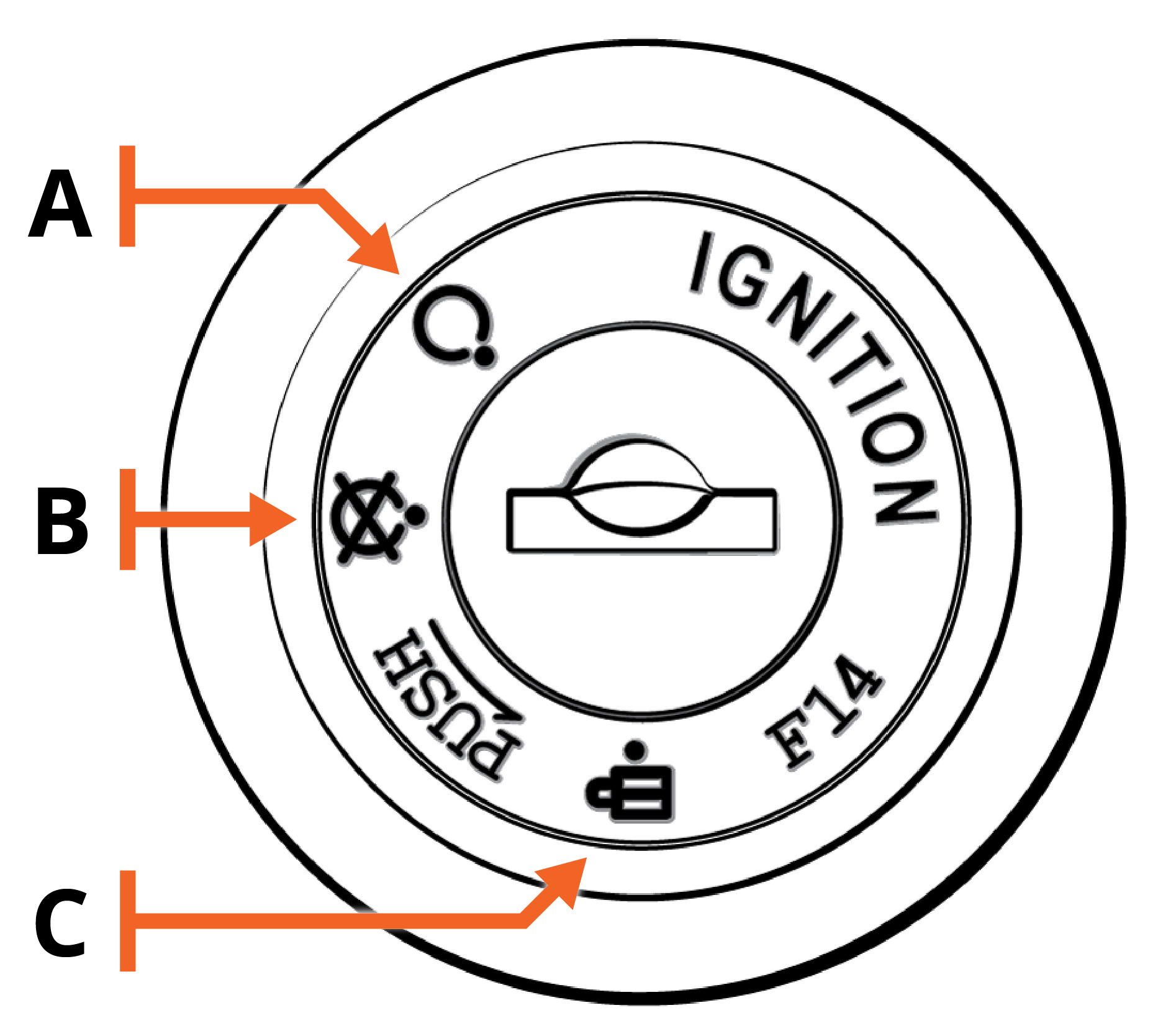 |
External battery keyport key positions: A = "On" (with battery locked to the frame) B = "Off" (with battery locked to the frame) C = "Off" (with battery unlocked from the frame, i.e., for removing the battery) |
Semi-integrated battery ebikes
For ebikes with semi-integrated batteries, simply push the POWER button on the Rad UI remote or Color Display remote to power on the ebike. The key is only needed when unlocking and removing the battery from the frame.
Integrated battery ebikes
For ebikes with integrated batteries, simply push the POWER button on the Color Display to power on the ebike. The key is only needed when unlocking and removing the battery from the frame.
External batteries
- Turn off the ebike. Press and hold the MODE button on the LCD Display remote (or the power button on the LED remote) until the display turns off.
- Unlock the battery. Insert the key into the keyport, then push and rotate the key to the OFF unlocked position.
- Remove the battery. When in the OFF Unlocked position, you can carefully slide the battery upward and lift it off the frame. Note that the battery weighs around 8 lbs, and must be handled with care.
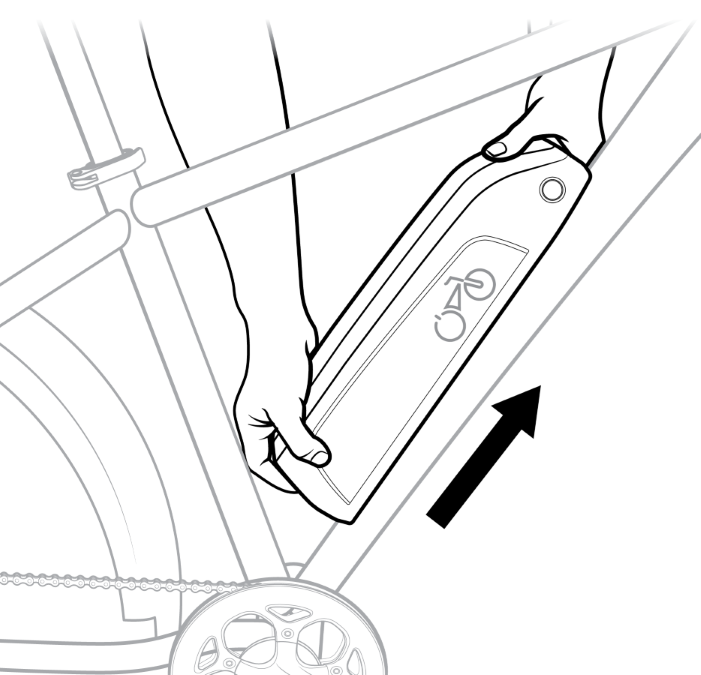 |
Semi-integrated batteries
Before removing your semi-integrated battery, turn off your ebike by pressing the power button on the Rad UI Remote until the display turns off. Then follow these steps:
- Unlock the battery from the frame. Insert the key into the keyport and turn to the unlocked position, and the battery will partially eject.
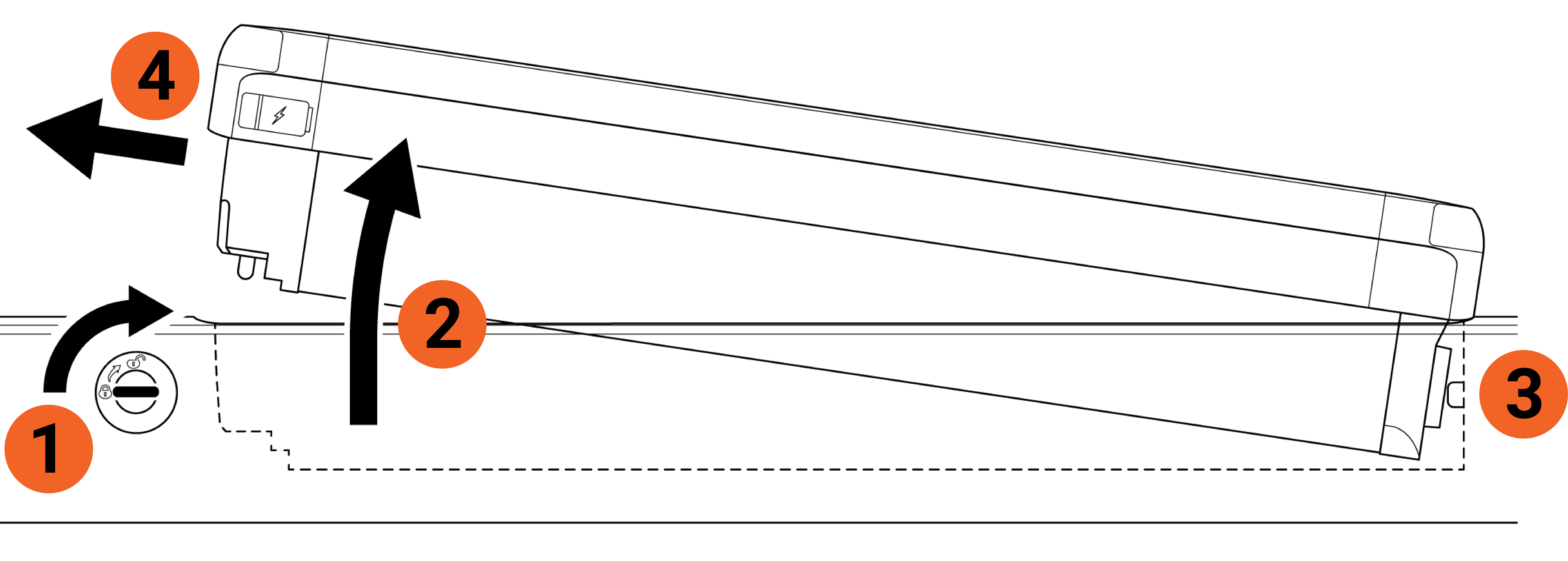 |
- Lift the battery carefully. Carefully lift the battery out of the integrated battery mount.
- Gently pull the battery away from the battery terminals ("3" in the illustration above) in the direction indicated with the arrow labeled "4" in the illustration.
Integrated batteries
Before removing your integrated battery, turn off your ebike by pressing the power button on the Color Display until the display turns off. Then follow these steps:
- Unlock the battery from the frame. Insert the key into the keyport and turn to the unlocked position, and the battery will partially eject.
 |
- Lift the battery carefully. Carefully lift the battery out of the integrated battery mount.
When the battery is removed
- Do not touch the “+” and “-” terminal contacts on the bottom of the battery when the battery is removed from the bike.
- Be careful not to drop or damage the battery when loose from the ebike.
- Avoid damaging the exposed connector terminals and keep them clear of debris.
When installing the battery
- Do not force the battery on to the battery mount; slowly align and push the battery down until the battery is securely mounted on the frame.
- Ensure the battery has been properly secured to the bike before each use by carefully pulling upwards on the battery with both hands to test the security of the attachment of the battery to the mount.
- Remove the key from the key port while the bike is in use.
Use caution to avoid damage to battery connector terminals, which are exposed when the battery is unlocked and removed from the frame of the bike. If your ebike did not come with a battery terminal cover, you can purchase one HERE and use it to protect your battery terminals when your battery isn't on your ebike. In the case of damage to the terminals or battery mounts, please discontinue use and contact Rad Power Bikes Product Support immediately.
There are two ways to check a battery's current charge level readout--on the battery itself, and on the display or remote.
Battery Gauge
All Rad Power Bikes batteries have LED lights on them to show state of charge. This is an easy way to check whether the battery is charged before you turn the ebike on, and is also helpful should you ever need to isolate whether a power problem is with the battery or ebike. Press the battery button next to the LED lights while the ebike is powered off or stopped.
Display or Remote
You can also check the amount of remaining battery on the display or remote when the ebike is powered on. The display options will vary based on the type of display that came with your ebike.
The display calculates battery life based on the battery power output (instantaneous voltage reading) and can fluctuate while riding if power demand and/or output changes. If you are riding, the battery reading will stabilize at the current battery capacity after about 5 seconds when power assist is off (pedal assist 0 and no throttle applied), the brakes are not activated, and while coasting on the bike.
 |
LCD display (some ebike models with an external battery) The LCD display shows a battery gauge in the top left corner of the screen when the ebike is turned on. |
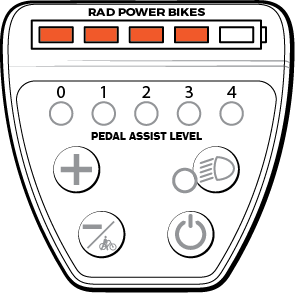 |
LED display (some ebikes with an external battery) The LED display shows a battery gauge at the top of the display. |
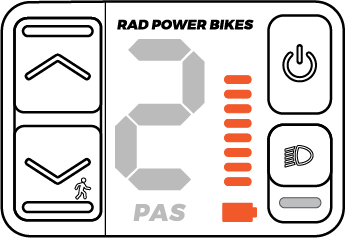 |
Rad UI Remote (some ebike models with semi-integrated batteries) The Rad UI remote shows the battery level indicator in the middle of the remote, above the battery icon. The Rad UI remote will show up to ten bars of battery level. |
.png?revision=1&size=bestfit&width=335&height=224) |
Color Display (2024 ebike models with external and semi-integrated batteries) The Color Display shows the battery level indicator in the middle of the remote, above the speed readout. In addition, the display will also show the battery percentage remaining, or mileage remaining estimate. Refer to your Owner's Manual for instructions on how to switch between these display options. |
 |
Color Display (ebike models with integrated batteries) The Color Display shows the battery level indicator and battery percentage remaining above the speed readout. |
Batteries depend on chemical reactions to charge and to release energy, and these reactions are most efficient at moderate temperatures. At very low temperatures, your battery may not charge or release energy efficiently or at all. At very high temperatures, your battery can get too hot, causing internal damage or even a fire hazard. Your battery is designed to shut off automatically at extreme temperatures, but you still need to be careful.
Please review the recommended temperature ranges below to get a sense of where and when you can safely ride, charge, and store your ebike battery. Please see your Owner's Manual or the Battery charging guide for additional safety information.
Recommended use (riding) range: 5°F to 105°F (-15°C to 40°C)
Your battery can withstand riding temperatures that your body may not withstand very well, so take care riding in extreme temperatures for your own health as well as your battery's. Riding in colder or hotter temperatures than those listed above increases the risk of harmful internal battery temperatures.
Do not ride in extremely hot temperatures. The more the ambient temperature exceeds 105°F (40°C), the greater your risk of exceeding a maximum internal battery temperature of 131°F (55°C). This can cause the battery to turn off as a safety precaution. Extreme heat may also cause critical failure of the battery up to or including an electrical fire. Factors that increase your risk for battery overheating include, but are not limited to, ambient temperatures above 105°F (40°C), direct sunlight for extended periods, high throttle usage, high PAS level, high payload, steep inclines, and other environmental factors.
Extreme cold of 5°F (-15°C) or below can cause the battery to shut off automatically to prevent damage. Do not depend on battery power to return you back to safety if riding near those extreme temperatures. Riding in freezing temperatures can also expose your ebike to de-icing salt, which can harm your ebike and electrical components or cause an electrical fire. See “Guard against rust, corrosion, and electrical damage” for more information.
Recommended charging range: 41°F to 77°F (5°C to 25°C)
For best charging performance and to minimize wear and tear on components, we recommend charging at ambient temperatures of 41°F to 77°F (5°C to 25°C). Batteries generate heat while charging, but your battery from Rad Power Bikes is designed to air-cool, so keep it uncovered with the light facing up on a flat, stable, hard, unheated surface. At relatively low temperatures, charging can take longer.
Do not charge your battery when it is warm from riding or in ambient temperatures above 100°F (38°C) to prevent unnecessary wear and tear on battery and charger. If the battery has turned off to prevent heat damage, wait until the battery cools down to turn the battery back on. Never charge your battery on or near heat-generating devices.
Recommended storage range: 14°F to 77°F (-10°C to 25°C)
Recommended long-term (more than two weeks) storage range: 40°F to 77°F (5°C to 25°C)
Always store your battery in a dry, indoor location. For long-term storage, we recommended you keep your battery charged to about 40%-70% of a full charge.
Storing your battery above 131°F (55°C), such as in a hot car in direct sunlight, can cause permanent range decline or critical failure, and could lead to electrical fire, serious injury, or death.
Long-term storage of your battery at temperatures above 95°F (35°C) or below 40°F (5°C) can reduce battery performance and lifespan.
Don’t store your battery long-term at full charge, zero charge, or very little charge. Storing your battery for long periods at full charge can cause range decline over time. Storing your battery for long periods at very little or no charge can cause permanent range decline or a non-functional battery.
Range
The battery gives most of our ebikes a range of between 25-45 miles on a single charge depending on riding characteristics: how much pedal assist and throttle is used, amount of weight carried, terrain, hills, and tire inflation. You can increase your range by sticking to a low level of pedal assist (0-2) and minimizing throttle usage.
Battery life
This depends on several factors, including how frequently an owner discharges and recharges the battery.
- Frequent riders: A rider who drains a full battery and recharges it back to full every day, seven days a week, will see about 2.5 years of life from their battery.
- Casual riders: A casual rider's battery can last closer to 6-7 years.
Best practices for extending range and battery life
- Whenever possible, avoid applying full throttle when your ebike has slowed to very low speeds, has stalled, or stopped.
- Pedal to assist the motor when climbing hills and accelerating from a stop.
- Do not climb hills steeper than 15% in grade.
- Avoid sudden starts and stops.
- Accelerate slowly.
- Avoid riding in extremely cold or hot temperatures.
Battery replacement
Our high-quality batteries will provide years of dependable power, but when a spare or replacement battery is needed, it's easy to replace! You can purchase an extra battery (great for extending your range on long trips!) or a replacement battery HERE.
Please follow these critical safety instructions to keep you, your battery, and your property safe. You must also follow all safety instructions in your Owner's Manual and other articles on this Help Center.
Never open the battery housing, which can expose you to caustic substances and electrical shock. It can also create a fire hazard, which can lead to serious injury or death. Opening the battery housing may void the warranty.
Never immerse or submerge the battery in water or liquid, including water in the battery mount, which can cause damage, serious injury, or death. If the battery was immersed or submerged in water or another liquid, do not use the battery.
Using aftermarket battery accessories or products that have not been tested by Rad Power Bikes for safety and compatibility may void your warranty, result in ebike or other property damage, create a safety hazard, or cause injury. If you use products not tested and recommended by Rad Power Bikes, you do so at your own risk.
Always follow any safety information attached to the battery or charger. A samples of such a label is shown below (your battery's label or labels may be different). Do not remove such labels from the battery.

Rad Power Bikes strives to be responsible for the environment, and lithium-ion batteries are recyclable and not just waste! Thankfully, battery recycling programs are becoming more accessible to everyone. Rad Power Bikes has partnered with Redwood Materials to recycle ebike batteries when they reach the end of their lifespan.
- If you live near a Rad Power Bikes service center, you can take your batteries there for recycling. A list of Rad Power Bikes service centers can be found HERE.
- If you do not have a service center near you, consult your local government's waste management resources about what battery recycling options might be available where you live.
Thank you again for helping keep reusable items out of landfills. We are always looking for ways to improve our environmental sustainability, and will be sure to announce any updates to our processes that can help customers dispose of their ebike items safely.
For more detailed operation, maintenance and critical battery safety information, refer to your ebike's Owner's Manual.

